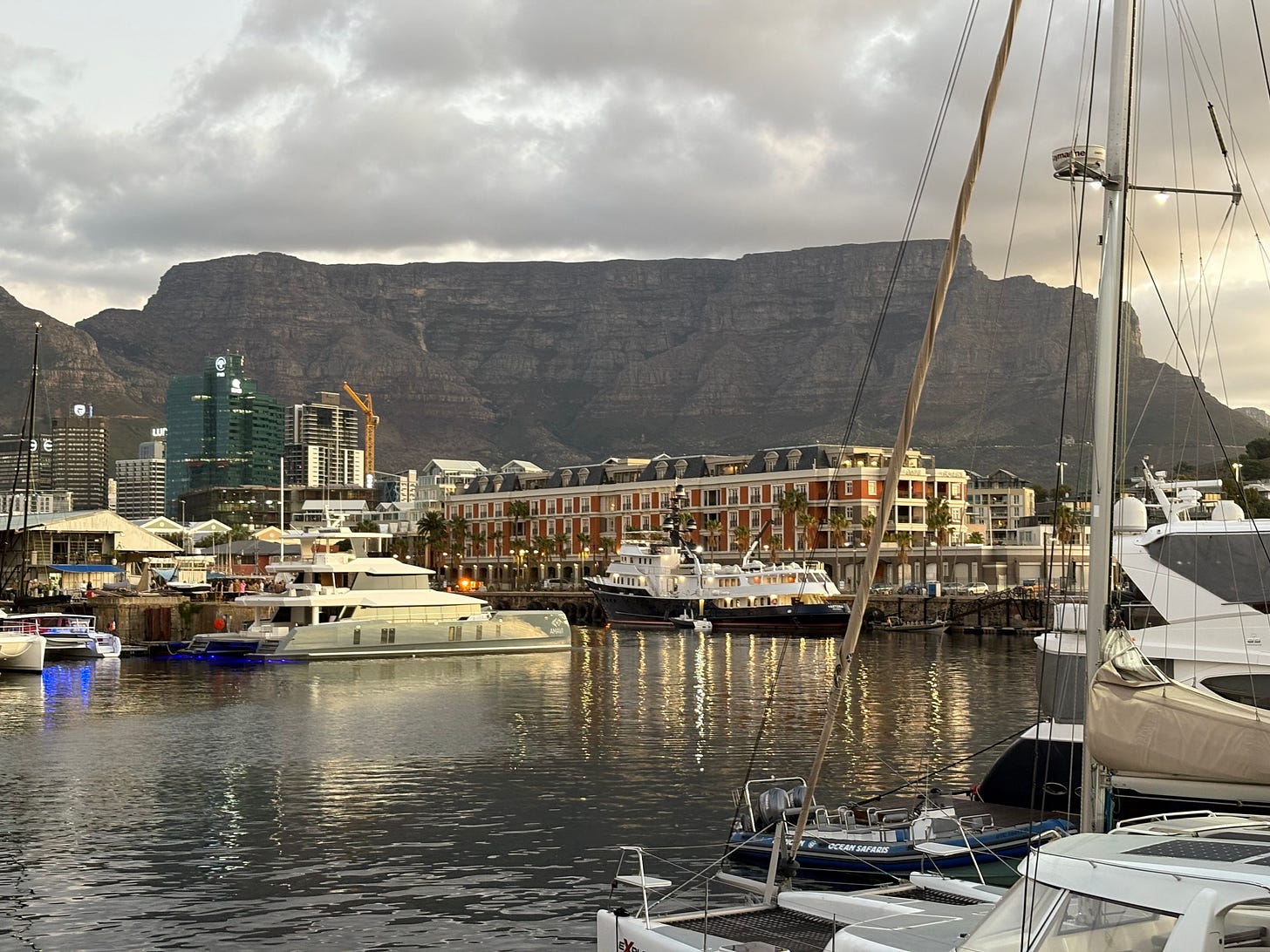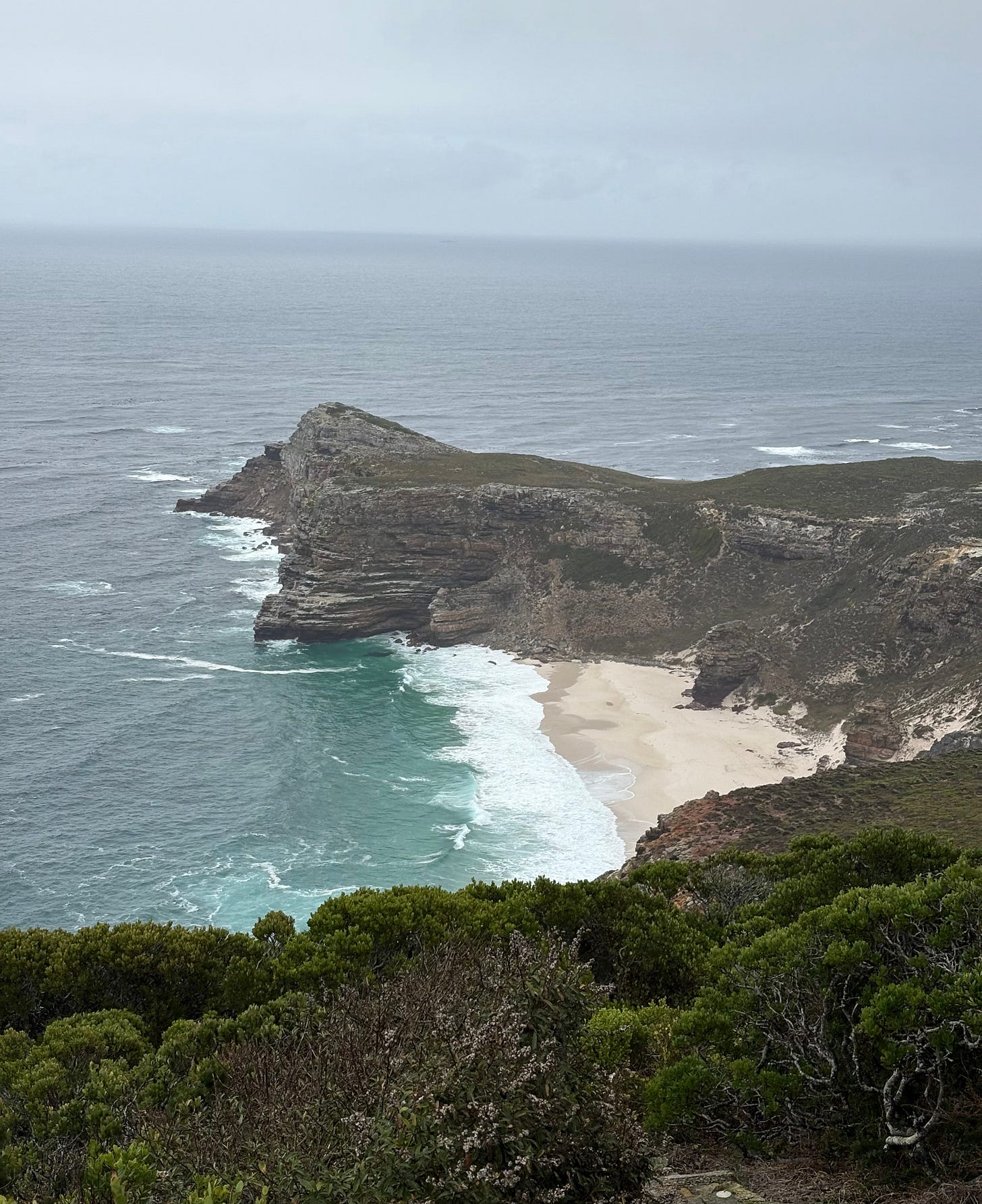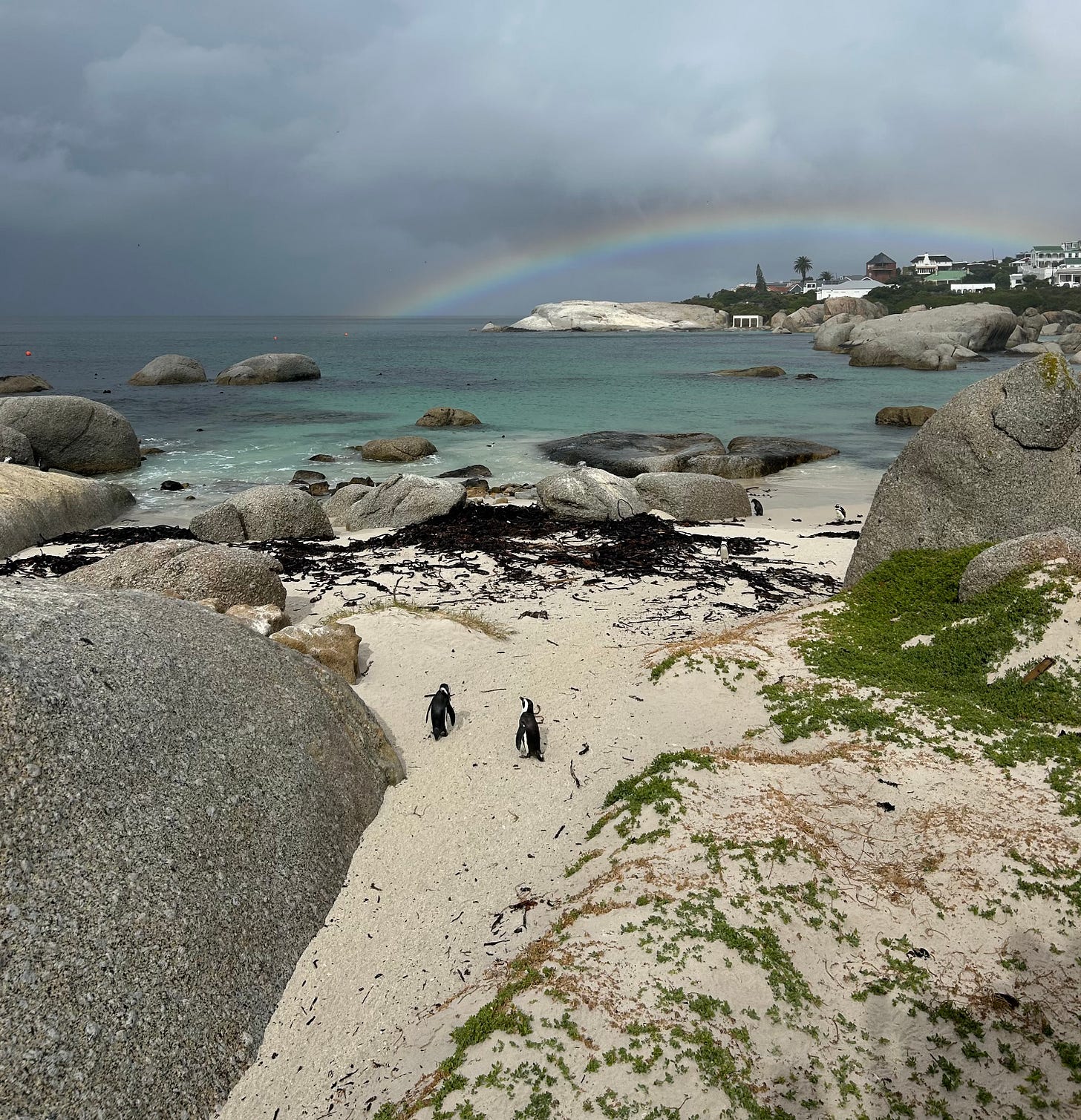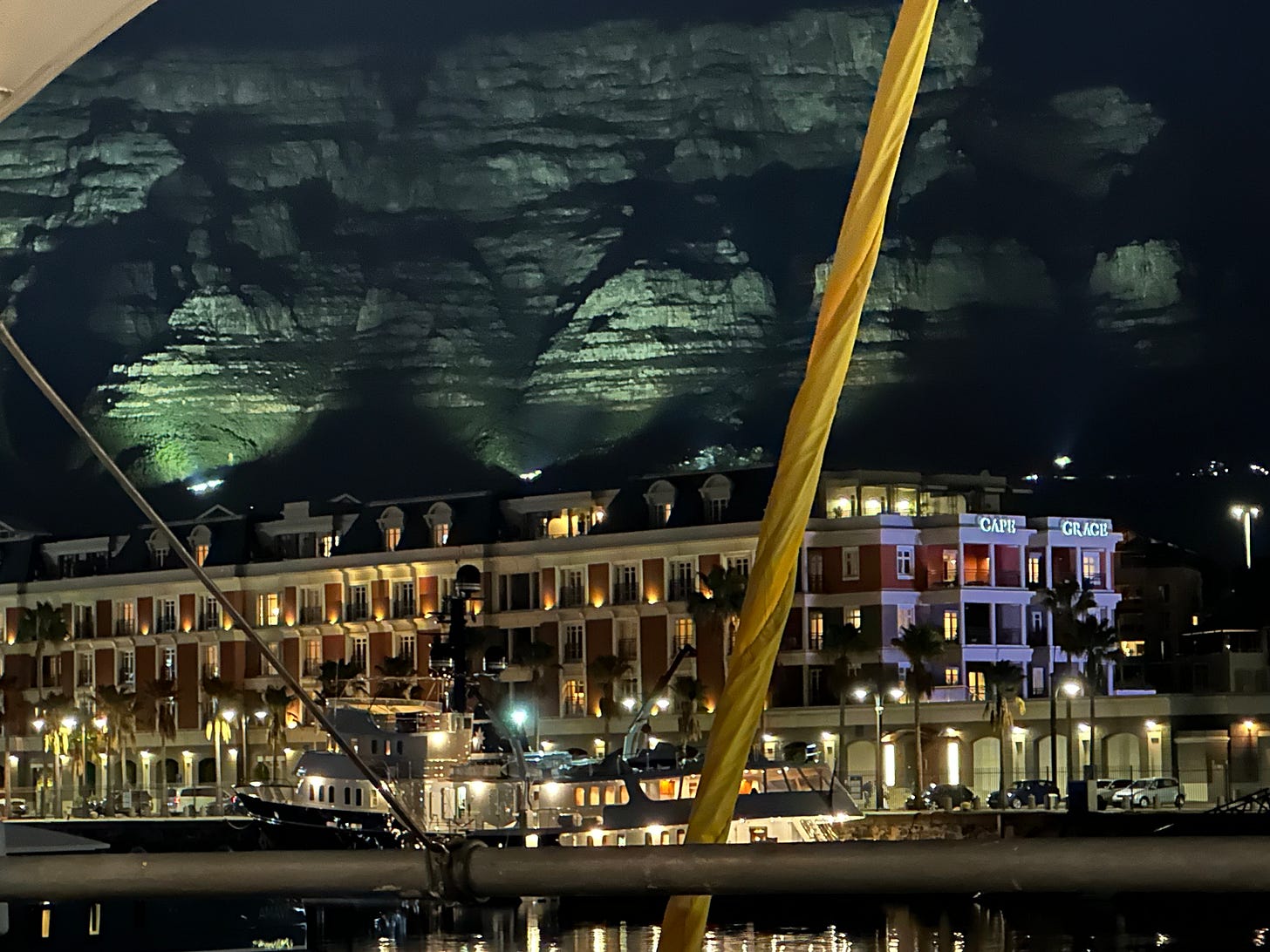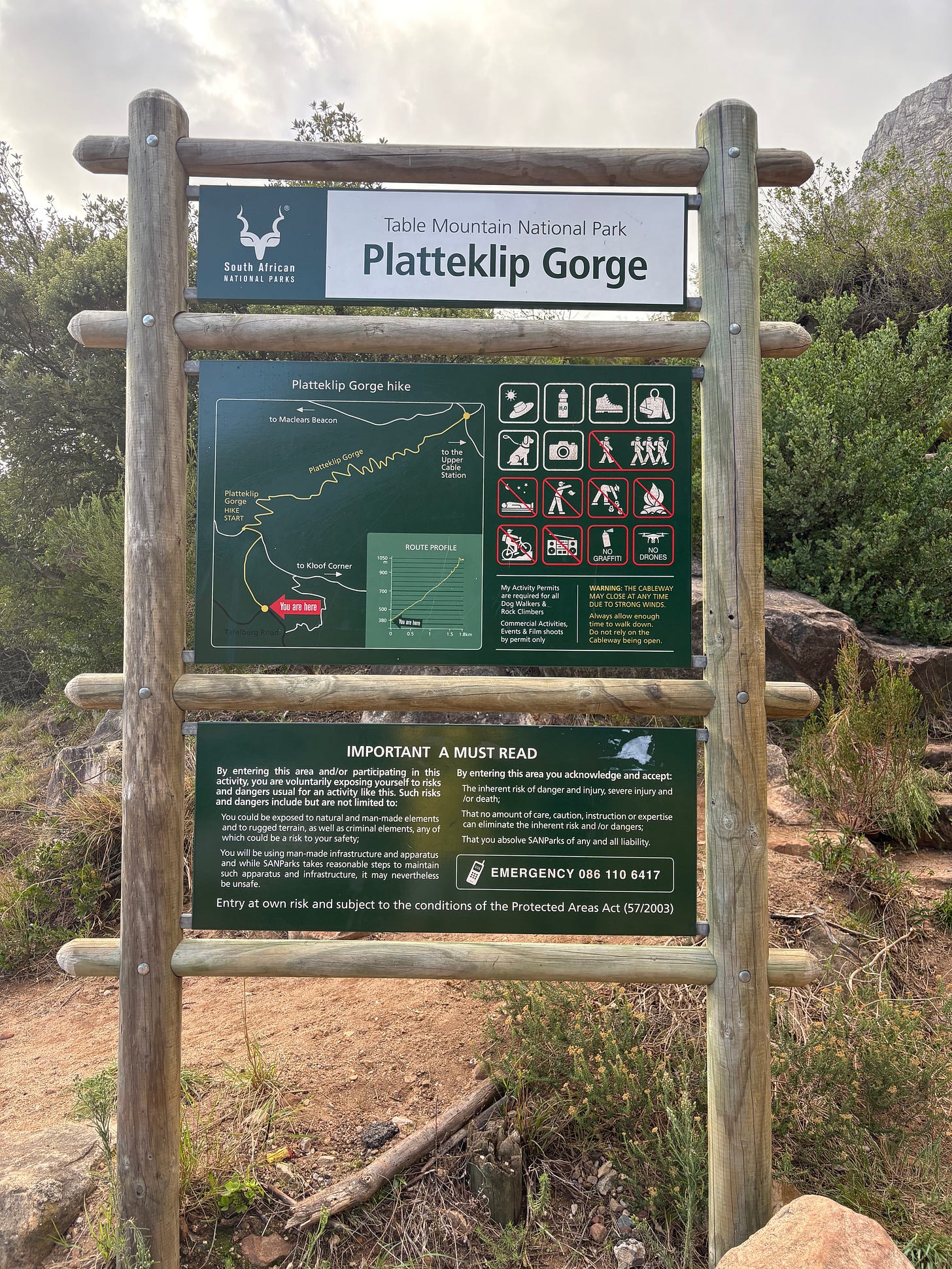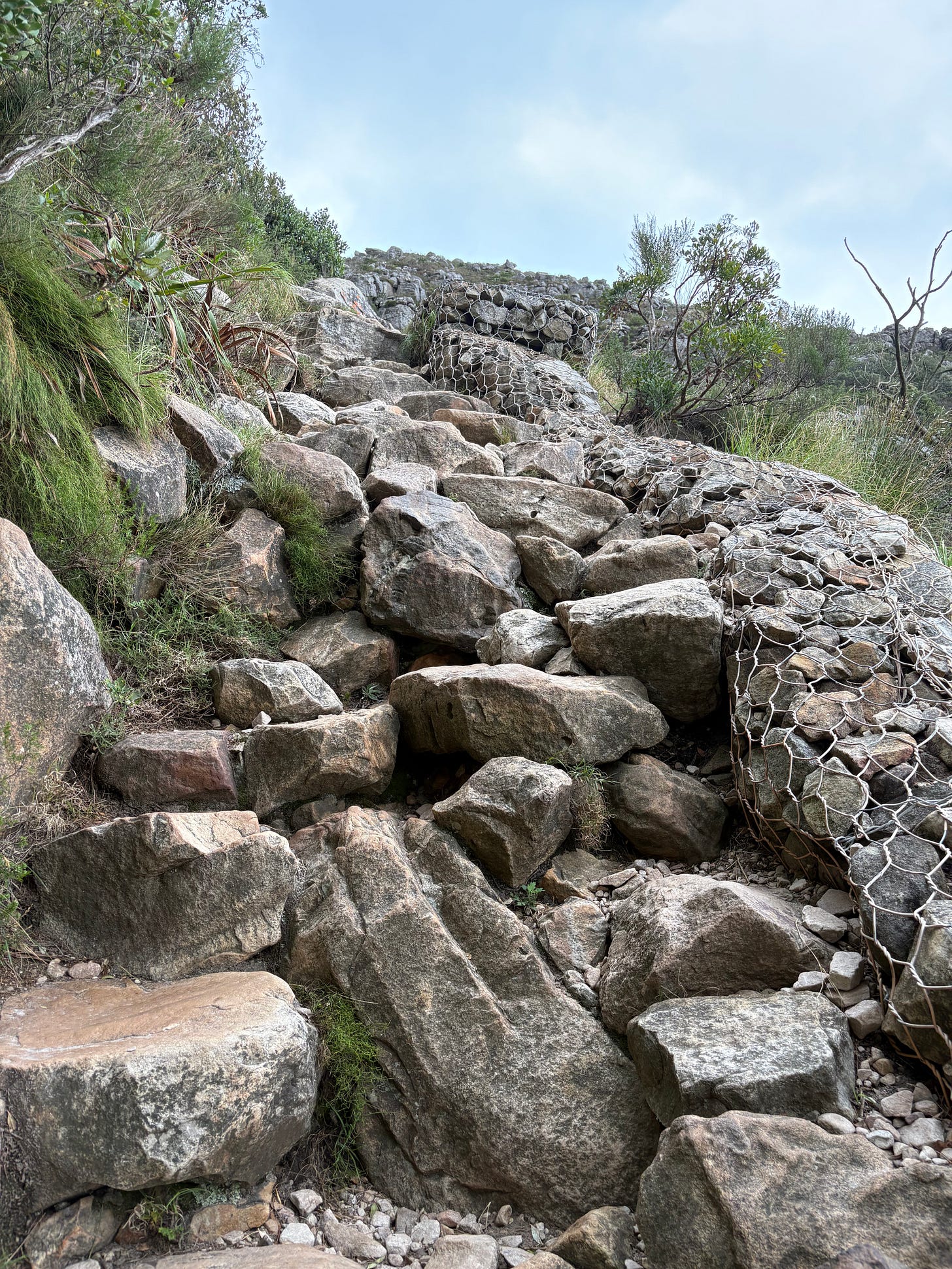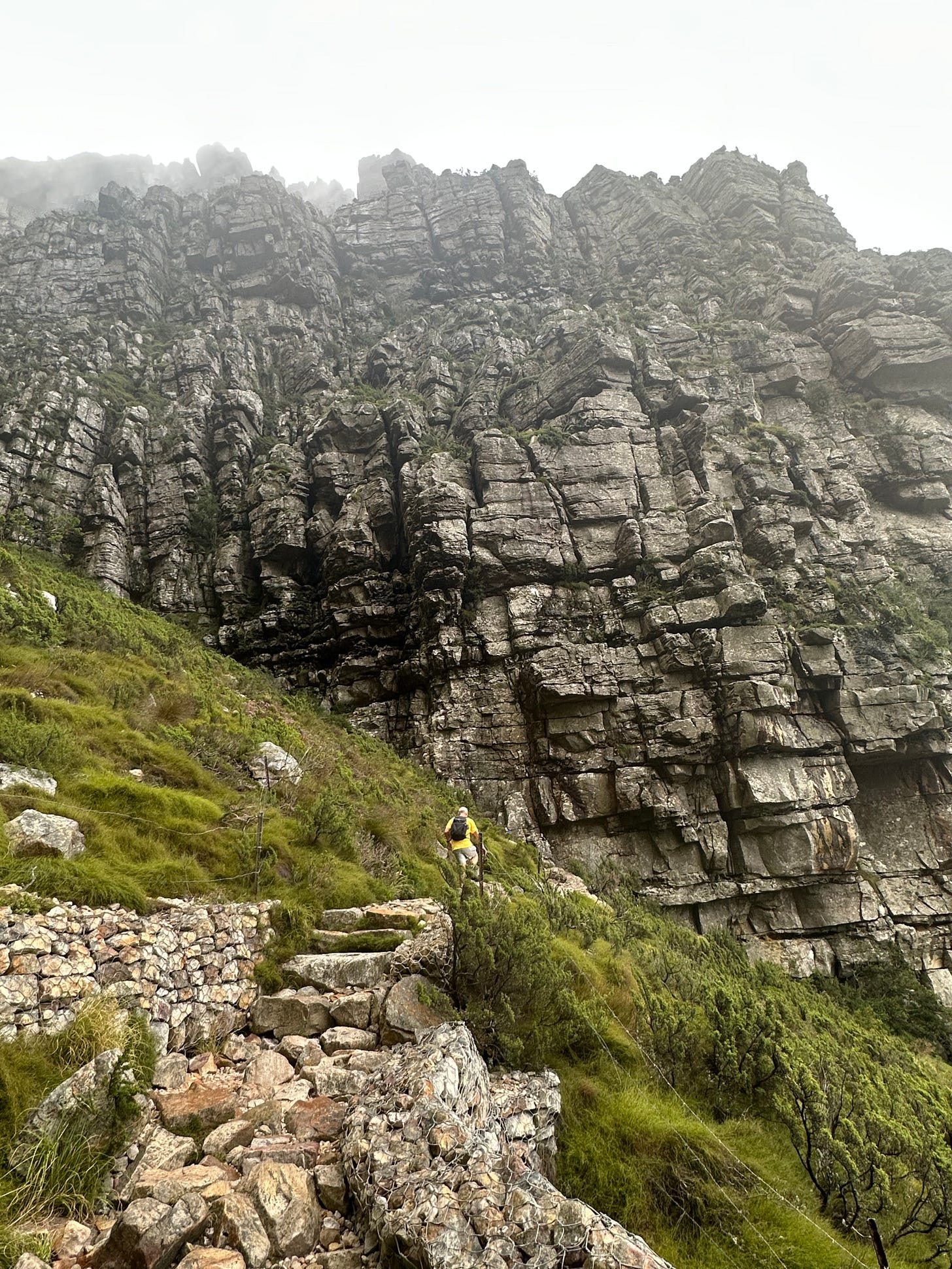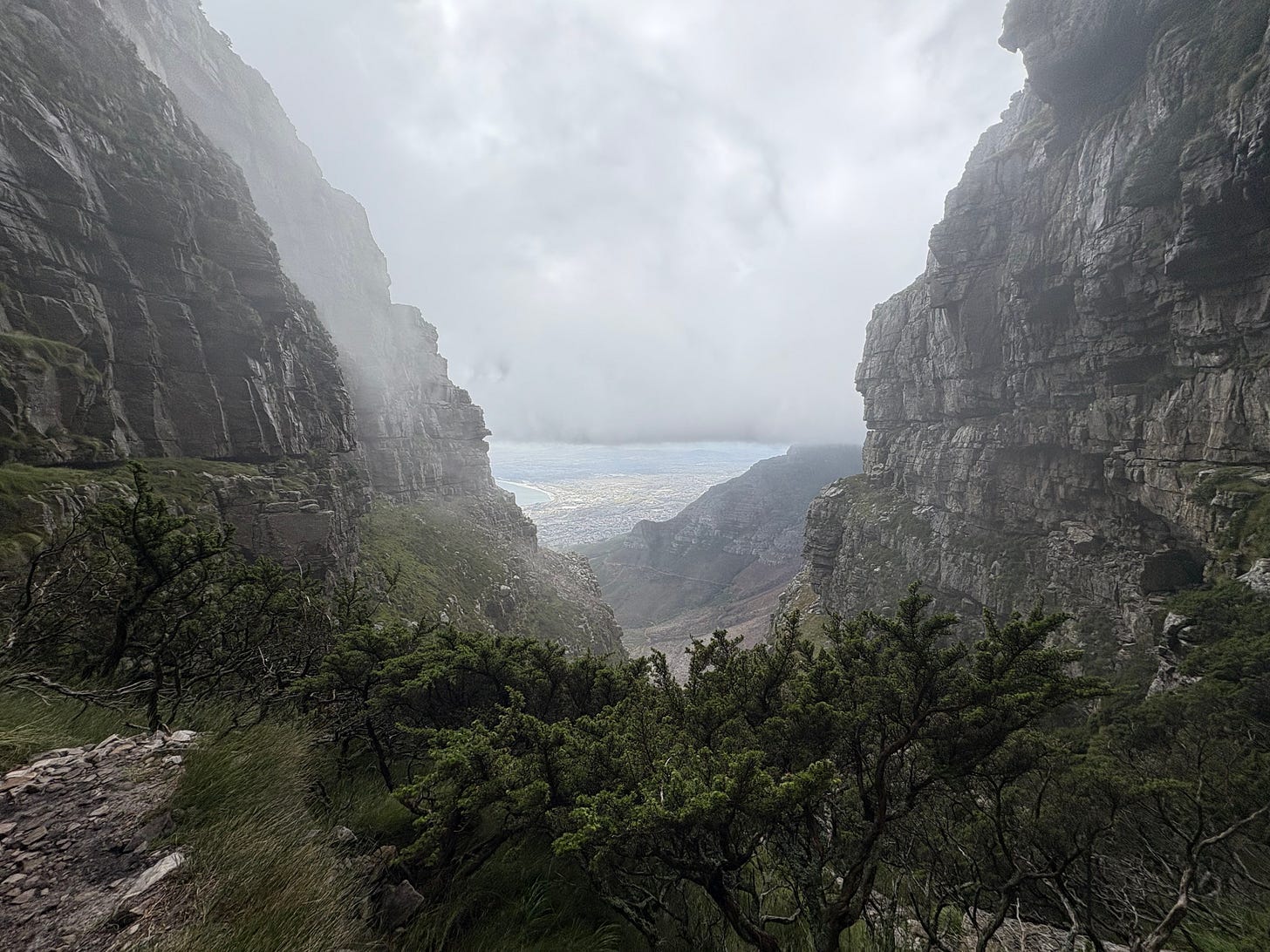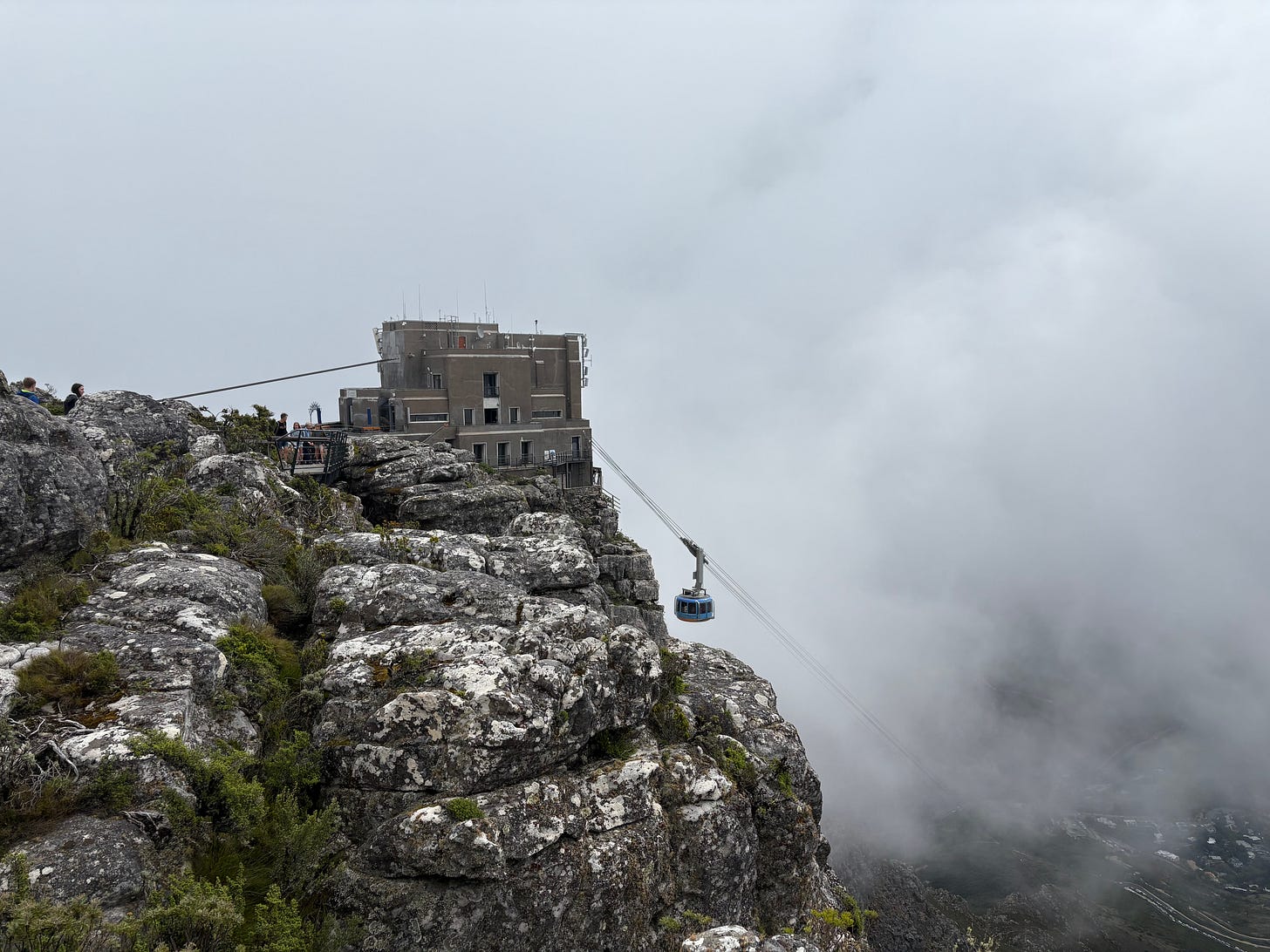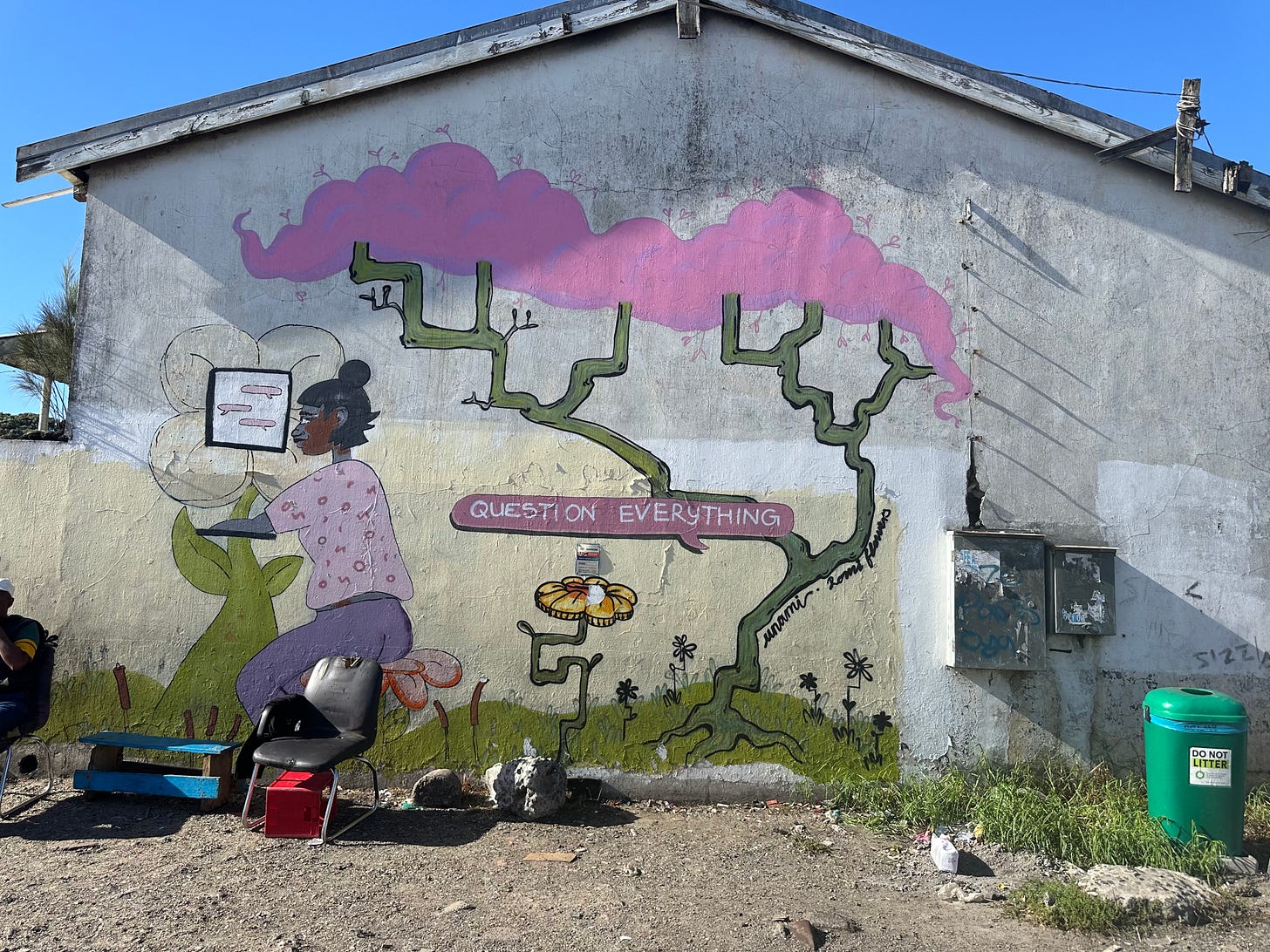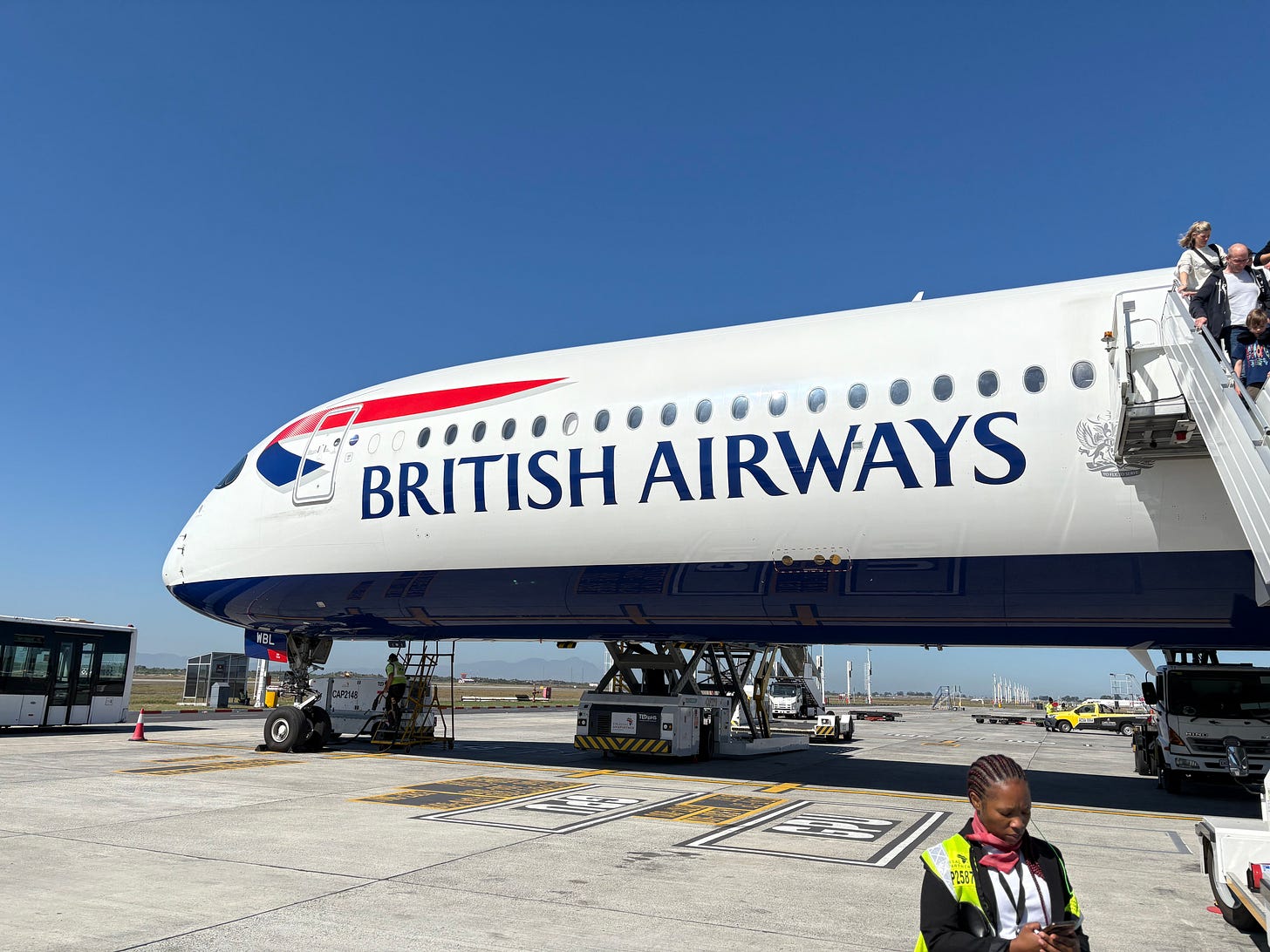Cape Town: Climbing Table Mountain
The Platteklip Gorge route. Plus: Cape Town perspectives, the good and the troubling. And travel and non-rev tips.
There was a time around 15 years ago when I became obsessed with climbing Kilimanjaro, Africa’s highest mountain. That climb requires endurance, but no technical skills. As mid-life crises go, it was a more wholesome idea than, perhaps, buying a red sports car, dyeing what was left of my hair, or whatever else I was meant to do to ward off the interest of the Grim Reaper in my fifties. But the project fizzled when I began instead to obsess about running, making that a more enduring and sensible way of addressing the actual root of the issue, which was my mid-life concern that I really ought to get in better shape.
As I near my seventies, part of me has continued to look wistfully toward Mount Kilimanjaro. At this post-mid-stage of life, however, I suspect the closest I’ll get will be to run the Kilimanjaro Half Marathon, which takes place each February or March in Moshi, the town in Tanzania from which most climbs set out.
But when I was recently planning a trip to Cape Town with my wife, I realized I had an opportunity to climb a somewhat more accessible, but still iconic African mountain, one that involves only a day hike and no danger of altitude sickness. Some might compare that to settling on a 5K after giving up on running an ultra-marathon. But an iconic mountain is an iconic mountain. Even though we were on a short, four-night trip — visiting our son doing a study abroad at the University of Cape Town — I was determined to make it on foot to the top of Table Mountain, the rectangular, flat-topped mountain that dominates South Africa’s second-largest city.
Cape Town perspectives (part one, the nice bit)
Cape Town has a population of a little under five million. But you don’t always feel you are in that big a city — at least, not in the areas visitors are most likely to frequent. One of the reasons is the feeling of being close to nature. Cape Town lies at the foot of three mountains: Table Mountain itself, Devil’s Peak, and Lion’s Head. And the city center abuts hiking trails on all three. Cape Town is one of those cities where what is conventionally viewed as the “center” is not really the “middle.”
Lying right at the bottom of Table Mountain is Kirstenbosch National Botanical Garden, with its own close-in hiking that blends into the mountain. Kirstenbosch is one of the world’s great botanical gardens, not only on account of its botany but also its stunning location. It is well worth including in a Cape Town visit even if you have limited interest in botanical science.
To the south of the city is a spectacular peninsula leading to the Cape of Good Hope, an easy day trip. That affords even more hiking, but — if time is short — it’s well worth a drive just for the views.
We stopped along the way to see the penguins ever present at Boulders Beach on the east side. You should try to get to the west side too for some of the most stunning coastal landscapes on the peninsula.
The city itself includes a vibrant, highly developed waterfront area — the “V&A Waterfront” — with fancy shopping malls, restaurants, and bars. (“V&A” is short for “Victoria and Albert,” referring to the nineteenth-century British monarch and her husband.)
All in all, Cape Town can be a very agreeable place to visit. But there is also a more troubling perspective. More about that shortly, but first back to climbing Table Mountain.
Getting to the top (and bottom) of Table Mountain
Table Mountain is 3,563 feet (1,085 meters) tall at its highest point. The easiest way to get to the top is to take the cable car. This departs from Tafelberg Road at an altitude of 991 feet. It takes you to 3,501 feet — so pretty much to the top.
However, you’ll get a much better feel for the mountain — and a more memorable experience — if you hike. You can always take the cable car down if you want to experience the ride. Or, I suppose, you could take it up and then hike down — but that would be less satisfying.
There are various routes, some of which can involve scrambling and navigating ledges that wouldn’t be ideal for those affected by vertigo (e.g., me). But there is one route that involves neither of those and should be doable for anyone who is moderately fit. This takes you up via Platteklip Gorge.
The Platteklip trailhead is on Tafelberg Road, about a quarter of a mile past the cable car station. When you pass the tour buses lined up for the cable car, you’ll be glad you’re avoiding the crowds and lines. Ubers are cheap and plentiful in Cape Town, and offer the best way of getting to the trailhead. The app recognizes “Platteklip Gorge starting point” if you put that in as your destination.
Platteklip Gorge is the most popular of the routes to the top of Table Mountain. Navigating it is straightforward. There are a couple of forks quite early on, but there are signposts and we never had to look at a map for directions. There was a park ranger at the trailhead to answer questions. But it’s hard to see anyone getting lost even without ranger input.
The same, however, may not be true of some of the other routes. Some of those appeal to people looking for a more challenging climb or one with more variety. There are tour companies that provide guides to help you climb Table Mountain, which you may want to consider if going for one of the trickier routes. With Platteklip, however, a guide really isn’t necessary.
The Platteklip trail features a lot of switchbacks and for much of it, you climb large, rocky steps. As climbs go, it is quite steep. Although the distance is only a bit over 2.5 miles, the elevation gain — according to my Apple Watch — was over 2,250 feet. There are pretty good views along the way. As you near the top, you climb within the vertical surrounds of the gorge itself.
The ascent can be done in under two hours. We ended up taking closer to two and a half hours, largely because I was quite careful not to slip. While the rocks on which you step aren’t wobbly, the stumble potential is nonetheless quite high, especially when — as on our hike — it has been raining. My wife and son would have made it to the top faster without me. I did clamber a bit at a few points, but with good balance, most people should be able to do the entire climb without using hands. You are never in danger of falling any distance if you do slip, but I was keen to avoid any type of fall. A cautious approach to fall risk is just part of ageing.
Table Mountain has its own microclimate. Even when the weather in the city seems generally good, parts of the mountain can get caught up in clouds and winds. And conditions can change quite quickly, as we found on our climb. So you want to bring layers to keep you warm and dry.
Every now and then, people do, apparently, get into trouble on Table Mountain. The Platteklip route should be the safest of all, partly because you are not alone. It wasn’t crowded when we ascended — on a Monday morning in April — but there were enough people that summoning help wouldn’t have been hard if necessary (and I believe you’re in cell coverage most of the time).
There have been robberies targeting hikers on the mountain. We didn’t encounter anything threatening, but it’s a point to keep in mind. That said, there’s a risk of crime wherever you go in Cape Town. If your tolerance for crime risk is very low, you probably shouldn’t go to the city in the first place. More on that later.
You reach the top of the trail not too far from where the cable car lands. And as you approach the cable car station — next to which is a restaurant — you’ll find yourself smugly mingling with non-hikers who had ridden up and are taking a leisurely stroll, looking a bit too neat and tidy to be at the top of a mountain amidst the swirling clouds. It doesn’t take much to figure out who has hiked to the top and who has taken the cable car.
We could have trekked further to the highest point. It wouldn’t have been much of a climb at that point — there’s only around 60 feet more elevation gain — but you should apparently allow an hour and a half to get there and back. However, it was cold and we had plans for the remainder of the day. And the cable car station felt like the top. It was top enough.
So after a bit of food and beverage, and a peek through the clouds at what view was available — including glimpses of Robben Island, where Nelson Mandela was imprisoned for 18 years — we took the cable car down. Fortunately, we only had to wait a half hour for our ride. At peak periods, be prepared for much longer waits if you don’t have a reservation. I think there is also some sort of “fast track” option if you want to buy your way toward the front of the line. Alternatively, there is always the hike back down.
Cape Town perspectives (part two, the troubling bit)
As noted earlier, Cape Town can be a very agreeable place to visit. But the city has its issues. Crime is one. Muggings, robberies, and worse are not uncommon. The murder rate is at the higher end of the scale. You can walk the streets in the areas you’d most likely be staying in or visiting, but you should be wary about doing so after dark except, perhaps, in crowded areas like the waterfront. On many streets, there’s someone — usually an older guy wearing a tattered hi-vis jacket — who “guards” parked cars and expects a tip. We never felt unsafe. You just need to be situationally aware and not make yourself an obvious victim-in-waiting.
Despite the crime, many people from North America and Europe who wouldn’t feel comfortable going to a lot African cities nonetheless gravitate toward Cape Town as it’s somehow more within their comfort zone. It’s ironic. For example, a city like Maputo in Mozambique might seem an edgier destination, but it is, in fact, a lot safer to walk around in.
Another issue, no doubt connected, is that Cape Town is still a racially divided city. Apartheid — the enforced racial segregation system that previously made South Africa a pariah state — ended over 30 years ago. But there are areas — including in the city center — where most people seem to be white. And then there are the “townships” — the areas to which non-whites were once confined — which remain entirely black.
On the same day that we climbed Table Mountain, we drove to Stellenbosch, a prosperous university town in the heart of the Cape’s bucolic wine-growing area, to see a rugby match and have dinner. South African wines are very good, by the way, and can be remarkably well priced. The match was between Stellenbosch and the University of Cape Town (UCT). In contrast to UCT, the Stellenbosch campus is still predominantly white. Many of the students there speak Afrikaans, the Dutch-derived language originally used by white settlers. The town must surely have the highest concentration of blond hair of anywhere in Africa.
Racial separation goes hand in hand with economic inequality. South Africa is the most economically unequal country in the world, according to the World Bank. And nowhere is the inequality greater than in Cape Town and the surrounding province. Chronic corruption only makes things worse. The African National Congress, which has ruled South Africa since the end of apartheid, has not had an unblemished record when it comes to ethical governance.
We visited the township closest to the city center, Langa. Estimates of its population vary greatly, but it’s probably over 100,000. You skirt its edges on the drive into the city from the airport. Most of its inhabitants live in pretty basic shacks. Some of these are made out of shipping containers or whatever materials people can find that would support a corrugated iron roof. Families often share what rudimentary kitchens and bathrooms exist. From peeks inside, they seem to do their best with very little. Most of these dwellings sport a satellite receiver.
A step up are some low-rise apartment buildings. Many families living in the most rudimentary conditions are on waiting lists to move up to these. But the waits are long. There are also pockets of middle-class housing. Some people who grew up in Langa and have had financial success in life prefer to stay close to their roots.
We signed up for a tour for our Langa visit. It makes sense to do so as you get to visit places you wouldn’t otherwise see, and you learn about the township as it is today and was in the apartheid days. The guides generally grew up and still live in the township. Our tour didn’t cover as much physical ground as I would have liked. There was a lot of standing around. And I found the guide a little hard to understand. But you’re supporting the local community by taking a tour, and it probably isn’t a great idea for visitors to South Africa to go wandering around townships on their own.
A few travel tips
Getting around: As mentioned earlier, Ubers are plentiful and inexpensive in Cape Town. But you may want to rent a car for at least some of the time, especially if you want to go down to the Cape of Good Hope or visit Stellenbosch and the wine country. People generally seem to drive well, so it isn’t a particularly scary place to get behind a wheel (although be prepared to drive on the left and — unless you pick a premium car — to be offered a stick shift).
Where to stay: Many visitors stay close to the waterfront. But that’s not necessarily the most interesting place to pick, as you’re in a bit of a bubble in that somewhat developed and curated environment. The Central Business District — CBD — has a good number of hotels. But we chose a new Canopy by Hilton property close to the CBD in an area called Gardens, which has a fair number of shops, bars, restaurants, and is a bit more residential. We were pretty happy with the hotel, which opened early in 2025.
Non-rev tips
We flew standby from San Francisco to Cape Town via London on British Airways. The routing was a last-minute decision taken at the airport. Although I have frequently flown on BA as a revenue passenger, this was my first time non-revving on BA long-haul. Here are some things I learned (for my general primer about non-revving on other airlines, click here):
Transit passengers avoid the high taxes at LHR: Normally, taxes out of London are very high — by far the highest in the world. But if you transit through Heathrow in under 24 hours, you can avoid the highest taxes. And you may be able to enjoy a quick stopover in the city, as you can leave the airport if time allows. Because of the lower taxes for connecting passengers, it is actually more expensive to non-rev on BA just from London to Cape Town than from San Francisco to Cape Town via London. I imagine you’d find the same with other routings through London. But your connection has to be on the same listing — and that means also on the same airline, as you can’t mix airlines on a single non-rev listing (even with code-share partners). That, in turn, means you can only really do this on BA or Virgin, the only long-haul airlines with hub operations in the UK. If you fly into Heathrow on, say, American and out on BA, you’d have separate listings and be hit with the high taxes even on a short connection.
Transit non-revs can get early confirmed connections on BA (maybe): BA doesn’t let non-revs check in online. Checking in at the gate at San Francisco, the lead agent gave us boarding passes with seat assignments not only for the flight to London, but also the onward one to Cape Town — even though there was competition on the connection from other staff travelers. That’s potentially a game changer for connections, as you effectively jump the standby queue ahead of people originating their journey in London. But I’m not sure whether that is standard BA practice or whether the agent was doing us a favor. He was super helpful. We were late for check-in, and he could easily have turned us away. But not only did he work fast and furiously on his computer to get us on board — and with great seats — but he even “apologized” that he didn’t have any Business Class seats, despite the fact that we aren’t entitled to upgrades on that airline.
We non-revved back from Cape Town (CPT) to Washington Dulles (IAD) on United. It’s a long 16-hour flight. A couple of non-rev tips about that journey:
No-inbound premium: Normally non-rev ZED fares into the U.S. are much higher than out of the U.S. because of higher taxes at points of departure. But we paid only $99 for the CPT-IAD flight, the same as it would be in the other direction. I’ve never come across zero inbound premium before.
Early seat assignments: Cape Town is one of those airports where they don’t allow non-revs to standby at the gate (regardless of airline). You need to have a confirmed seat assignment before going through security. The last time this happened to me was with United in Hong Kong with my son, where we had to wait until revenue passenger check-in closed, leaving barely any time for a lounge visit once through security. This time, although the flight was pretty full, I got the “Good news!” text from United — it always begins with those words — two hours before departure, giving us decent seat assignments, even though it was a pretty full flight and I’d been fearful of us ending up separated in middles. That left time for a reasonably leisurely airside lounge visit. I’m not sure whether that is UA’s standard practice in Cape Town or whether we lucked out.
There are two Priority Pass lounges in the international terminal at Cape Town. Both are called “Bidvest Premier Lounge,” but the one you’ll see first when you enter the airside departure area is quite a lot smaller. So we went to the other about a couple of minutes’ walk to the left. I’d rate it high on the Priority Pass scale — quite spacious, a great buffet spread, decent wine, and friendly staff.
Our long-haul flights on BA and United were fine (all segments were in Economy — although I did score First Class on the transcon from Washington Dulles back to California). My wife sometimes brings goodie bags for the crew. She doesn’t expect anything in return, but it’s nice when it happens. On this trip, we got (proper) champagne, pajamas, cheese/fruit plates, and ice cream. ✈️
If you’ve stumbled across this post, please consider subscribing to this blog using the button below. It covers the intersection of running (or, with this post, hiking), travel, and aviation. Subscribing costs nothing — and never will — but supports the site. You’ll get an email every month or two with new posts.
For a list of other recent posts, click here.
And please share this post with others who may be interested, using this button:

